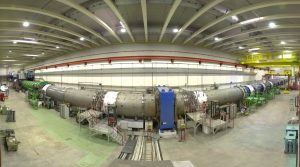On Tuesday, July 28th, during the 2020 International Conference on High Energy Physics, the CERN NA62 Collaboration announced that they have obtained the first statistically significant evidence for the occurrence of an extremely rare decay predicted by the Standard Model that could open the doorway to the discovery of new physics.
NA62, the 62nd experiment at the CERN SPS North Area, is an experiment designed to make high-precision measurements of kaon decays, and in particular, of the decay of a charged kaon into a charged pion and a neutrino-antineutrino pair, K+→π+νν. This decay, the subject of Tuesday’s announcement, is extremely rare and its rate is very precisely predicted by the Standard Model. Any deviation from the expected value would therefore be a sign of new physics, possibly explaining the nature of dark matter and other mysteries of the Universe.
The kaons are produced in collisions between a beam of protons from the CERN SPS and a beryllium target. These collisions generate a beam with a flux of nearly one billion particles per second. Of these, only 6% are kaons, of which only one in 10 billion undergoes the elusive decay K+→π+νν.
In their data set collected in 2018, with 1018 proton collisions on the target, the NA62 Collaboration identified 17 events that are candidates for the decay K+→π+νν, in addition to the three events observed in 2016 and 2017. NA62 obtained a number of candidate events with statistical significance of 3.5σ. The measurements are so far compatible with the Standard Model predictions.
The collaboration is preparing to collect an even richer data set during an experimental campaign to last from 2021 to 2024, with the goal of reaching the 5σ significance.
More than 70 physicists and technologists from nine INFN sections participated in the design, construction, and execution of the experiment, as well as in the analysis of the data. In particular, the entire photon veto system, consisting of 12 large detectors placed at intervals along the 100-m-long decay volume as well as smaller detectors at the downstream end of the experiment, was constructed at Frascati between 2009 and 2014, before the start of the data taking.
NA62 experiment https://home.cern/science/experiments/na62
LNF website http://w3.lnf.infn.it/ricerca/fisica-delle-particelle/na62/
 INFN-LNF Laboratori Nazionali di Frascati
INFN-LNF Laboratori Nazionali di Frascati
